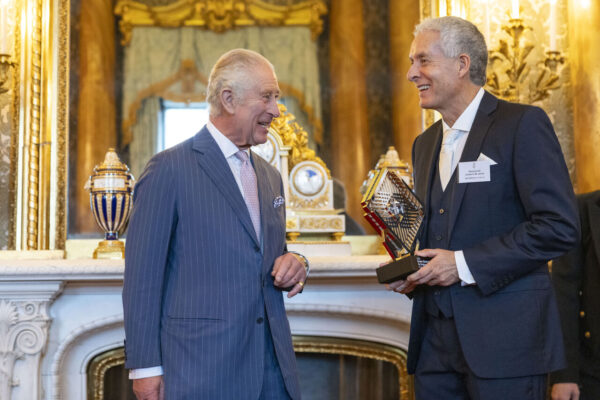Australian scientists Martin Green and Andrew Blakers, alongside former University of New South Wales (UNSW) alumni Jianhua Zhao and Aihua Wang have been awarded the 2023 Queen Elizabeth Prize for Engineering for the invention and development of Passivated Emitter and Rear Cell (PERC) solar technology, which has underpinned the global growth in high-performance, low-cost solar electricity.
The quartet were announced as winners of the QEPRize earlier this year and presented with their awards by King Charles III in a ceremony at Buckingham Palace overnight (AEST).
The four were part of a team at the UNSW that developed PERC technology, improving the quality of both the top and the rear surface of standard silicon solar cells. Their work helped increase the conversion efficiency of standard solar cells by more than 50% in relative terms from 16.5% in the early 1980s to 25% in the early 2000s.
The team’s innovations and advances in solar technology are considered instrumental in the global transition to renewable energy, helping reduce the cost of solar panels by 80% in the last decade with solar now the lowest cost option for bulk electricity supply.
Green, who led the UNSW team, said he was proud of the major impact the achievements of many of his former students, including his fellow awardees, have had on the world.
“As engineers, we are constantly striving to improve the world we live in,” he said. “As the world feels the devastating impacts of our changing environment and collapsing ecosystems, I feel passionately that we must rapidly reduce our reliance on fossil fuels if we wish to maintain the trajectory of human civilisation on our shared planet.
“I hope that PERC technology winning the QEPrize will highlight the importance of accelerated solar adoption to address climate change.”

Image: QEPrize
Wang, who along with her husband Zhao spent almost two decades working on PERC cells at UNSW before they returned to China, said she was grateful their work has played such a critical role in achieving energy efficiency targets.
“Achievements in engineering can have a remarkable impact all over the world,” she said.
Green’s lab at the UNSW held the global record for solar cell efficiency for 30 of the 40 years from 1983 to 2023. The awardees opted not to patent their pioneering work, freeing PERC technology to be widely adopted.
PERC technology is now the most commercially viable silicon solar cell technology for use in solar panels, accounting for almost 90% of the global solar cell market.
This content is protected by copyright and may not be reused. If you want to cooperate with us and would like to reuse some of our content, please contact: editors@pv-magazine.com.









By submitting this form you agree to pv magazine using your data for the purposes of publishing your comment.
Your personal data will only be disclosed or otherwise transmitted to third parties for the purposes of spam filtering or if this is necessary for technical maintenance of the website. Any other transfer to third parties will not take place unless this is justified on the basis of applicable data protection regulations or if pv magazine is legally obliged to do so.
You may revoke this consent at any time with effect for the future, in which case your personal data will be deleted immediately. Otherwise, your data will be deleted if pv magazine has processed your request or the purpose of data storage is fulfilled.
Further information on data privacy can be found in our Data Protection Policy.